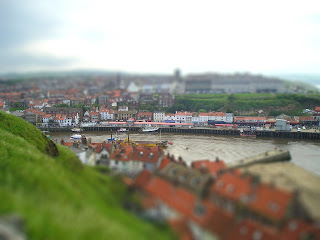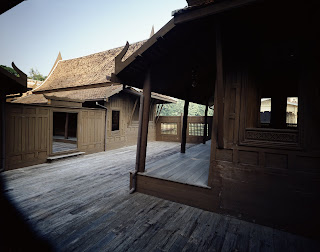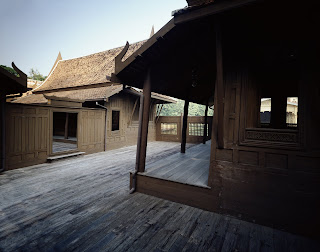The first thing i wanted to do in planning for my day in the life image was to have a little more of a play around with layers and some of the effects that can be produced. In my tutors notes on my first assignment he had included a very useful link to a site which takes you through the process of creating some different effects, the ones i chose to have ago at were creating a grunge effect frame and the king of the jungle image.

With the grunge effect frame above it was a matter of creating a blank file and then using layers and brush work to get the final effect how you wanted it. I will not go into detail but if you want to see the process in full follow the link on this page that says 25
photoshop effects. I like the effect but I'm not certain the photo suits it that well as it makes the image feel a little constrained.

The other process i attempted was the king of the jungle image, here you had to collect together all the different pieces such as the painting of Napoleon, the lions head and the skull in my version above and then using layers and blending effects combine them into the final version above. I did find that some of the pieces weren't available anymore and unfortunately some of the stages in the walk though i couldn't complete because I'm using a different software package to what they used but overall i think i manage to produce a very convincing image, this i found a lot of fun to do even though on first reading the walk through i felt it was going to be a really pain in the backside to do.
To get some idea at how other people have approached this assignment i had a look online and discovered a few examples. First i looked at Eileen
Raffertys blog Photosynthesis
http://www.flickr.com/photos/eileen_r/5482703586/in/set-72157625937913800/ ,here she gone for very small self portraits picking out individual characteristics of herself during a day. An interesting approach but a little lost on me on how this showed she'd used any of the methods learnt in the course up to this point.
Next i found on
flickr an image much more in keeping with what I'm thinking about attempting
http://www.flickr.com/photos/chaoticbeaut/4476623251/, here the person had used a combination of images of things they do during a day and thinks that have a meaning in there everyday life to produce a single image. I like the way they used the windows to show a completely different scene but the blending is really good and you can hardly tell its been add other then the fact it isn't a scene you'd ever see out of a window. I also looked at her inspiration which was Jeff Walls A View from a Apartment, i like the idea of taking shots from a single camera position and them combining them into one believable photo.
The final image i look at went for a very minimalist approach in that it only used three images to illustrate the idea of a day in the life
http://www.flickr.com/photos/b2photo/3898279396/, with this one i loved the way the shots had been blended together on the background even down to the reflections in the lower half of the frame but i did feel that maybe it could have done with a few more shots to illustrate the theme.
I got so interesting idea now to start building my own image and I'm looking forward to seeing what i produce, to be honest i feel that a collection maybe 5-10 images would work best for me so what
I'm planning to do is chose a subject and then follow that person through out the day so i can capture the parts of the day which best show what this person is like. I've already found a good background which
I'm planning to use its a door with some posts stuck to it, all i got to do is work out a way to get the texture of the paper to come through in my photographs maybe using layers and some of the blending options that
I've looked at in
previous projects but that will be
probably a little bit of trial and error.
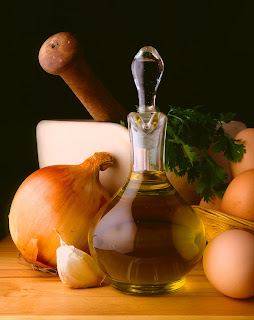 To begin with you're given the above image and told to duplicate it in layers so that you end up with 2 versions of the same image. Next you take the bottom layer and apply to it a Gaussian Blur which is found under filter>blur>gaussian blur, this is a simple filter which effects the radius of the blur and you're told to set it to around 5 pixels. Then moving back to the top layer and selecting the eraser tool i began to rub out the areas that i wanted the blur below to show through, in this case i wanted all the area behind the olive oil container to appear out of focus. Below are the results of this process and I'd have to say that it does appear just as i would imagine it would have if taken straight from the camera set to around f/5 or there abouts because the effect works that well.
To begin with you're given the above image and told to duplicate it in layers so that you end up with 2 versions of the same image. Next you take the bottom layer and apply to it a Gaussian Blur which is found under filter>blur>gaussian blur, this is a simple filter which effects the radius of the blur and you're told to set it to around 5 pixels. Then moving back to the top layer and selecting the eraser tool i began to rub out the areas that i wanted the blur below to show through, in this case i wanted all the area behind the olive oil container to appear out of focus. Below are the results of this process and I'd have to say that it does appear just as i would imagine it would have if taken straight from the camera set to around f/5 or there abouts because the effect works that well. 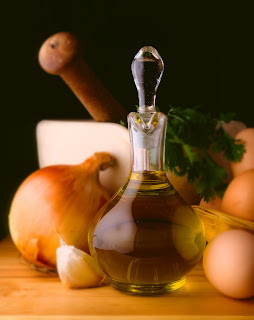 To take this process a step further I'm next asked to take the image and give it the feel of a more gradual blur, what i mean is that instead of the whole of the background begin blur at the same setting this time i blurred it in stages using two duplicate layers and the original. The image below was achieved by first taking the bottom layer and again using the gaussian blur filter but this time setting it to 10 pixels, next i selected the middle layer and this time set the filter to 5 pixels. Now i had to take the eraser tool and remove the areas which i wanted the more blurred layer below to show through, so in this case i went for the mortar and pestle and greenery. Finally working on the very top layer i used the eraser once more to remove everything but the olive oil container so that i ended up with a shot that had the feel i was looking for. If i had to chose which one of the two images I've produced i prefer I'd go for the second more gradual blurred image mainly because by using the Gaussian blur filter in this way the image feels as if it has far more depth to it then it actually has.
To take this process a step further I'm next asked to take the image and give it the feel of a more gradual blur, what i mean is that instead of the whole of the background begin blur at the same setting this time i blurred it in stages using two duplicate layers and the original. The image below was achieved by first taking the bottom layer and again using the gaussian blur filter but this time setting it to 10 pixels, next i selected the middle layer and this time set the filter to 5 pixels. Now i had to take the eraser tool and remove the areas which i wanted the more blurred layer below to show through, so in this case i went for the mortar and pestle and greenery. Finally working on the very top layer i used the eraser once more to remove everything but the olive oil container so that i ended up with a shot that had the feel i was looking for. If i had to chose which one of the two images I've produced i prefer I'd go for the second more gradual blurred image mainly because by using the Gaussian blur filter in this way the image feels as if it has far more depth to it then it actually has. To put this effect into use in one of my own photos i went for this image of a heron, the reason i chose this particular shot was because of the fact i hadn't had chance to get set up with my tripod so i ended up with all the background being in focus as well as the heron and this I'm afraid rather spoiled it in my eyes (see above). Here then i have a chance to rectify this problem so using the same process as before i create two duplicate layer and then used the Gaussian filter produced the tow layer of blurring. Below is the final version and what you can see is the more heavily blurred area is in the tree roots and on the bank, then slightly less blurred is the actual river around the in focus heron. This is much closer to what i originally intended but i still think that i could have blurred the bank and tree roots a little more not completely out of focus but just enough to give it even more feeling of depth. I like this effect alot and can see that it'll be very useful in the future as a fall back option if i don't get things right for one reason or another.
To put this effect into use in one of my own photos i went for this image of a heron, the reason i chose this particular shot was because of the fact i hadn't had chance to get set up with my tripod so i ended up with all the background being in focus as well as the heron and this I'm afraid rather spoiled it in my eyes (see above). Here then i have a chance to rectify this problem so using the same process as before i create two duplicate layer and then used the Gaussian filter produced the tow layer of blurring. Below is the final version and what you can see is the more heavily blurred area is in the tree roots and on the bank, then slightly less blurred is the actual river around the in focus heron. This is much closer to what i originally intended but i still think that i could have blurred the bank and tree roots a little more not completely out of focus but just enough to give it even more feeling of depth. I like this effect alot and can see that it'll be very useful in the future as a fall back option if i don't get things right for one reason or another.






